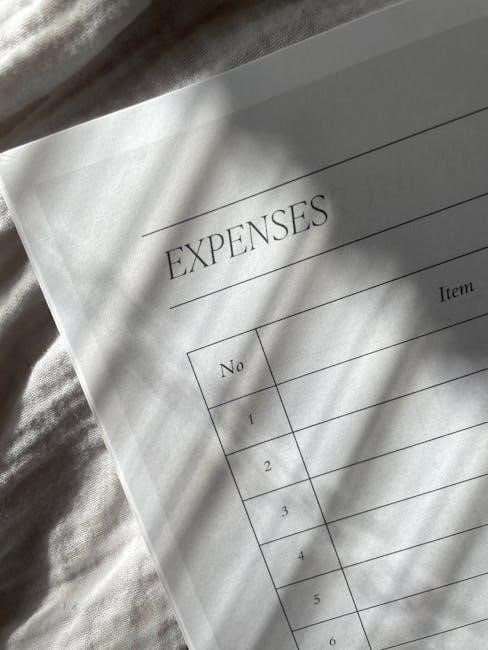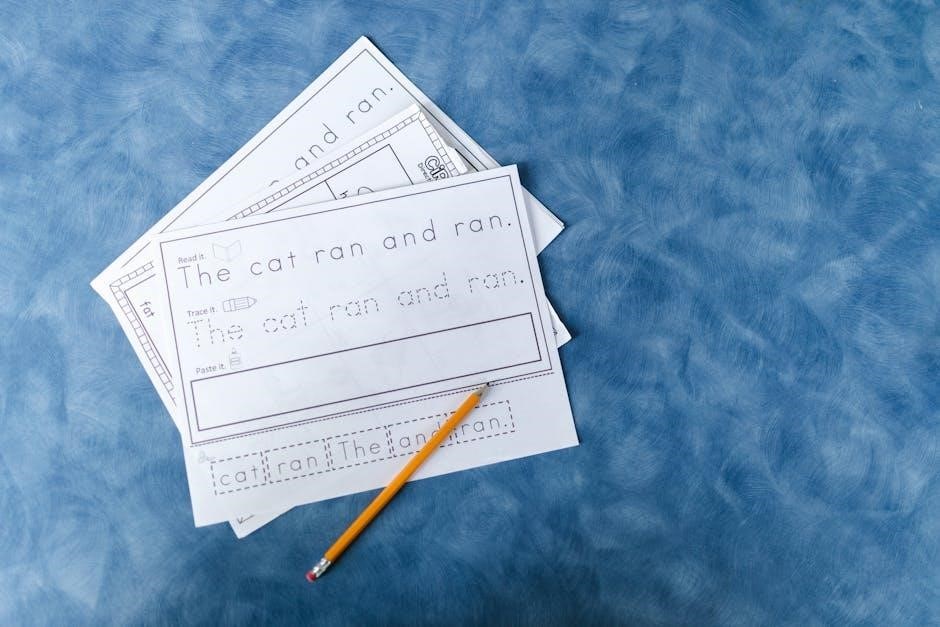Equivalent fractions are fractions that represent the same value despite having different numerators or denominators. They simplify comparing, adding, or subtracting fractions. Understanding them is foundational for advanced math concepts like ratios and proportions. These fractions are created by multiplying or dividing both the numerator and denominator by the same non-zero number. For example, 1/2 and 2/4 are equivalent because they represent the same part of a whole. Recognizing equivalent fractions is essential for simplifying expressions, solving equations, and real-world applications such as cooking, construction, and finance. Worksheets provide structured practice to master this skill, ensuring a strong mathematical foundation.
1.1 Definition and Basic Concept
Equivalent fractions are fractions that represent the same value, even though they may appear different. For example, 1/2, 2/4, and 3/6 are all equivalent because they simplify to the same decimal, 0.5. The basic concept revolves around multiplying or dividing both the numerator and denominator by the same non-zero number to create equivalent fractions. This fundamental idea is crucial for understanding fraction operations like addition, subtraction, and comparison. Equivalent fractions provide a way to express the same part of a whole in different ways, making them essential for various mathematical applications. They are a foundational skill in arithmetic and are widely used in real-life scenarios, such as cooking, construction, and finance.
1.2 Importance of Understanding Equivalent Fractions
Understanding equivalent fractions is crucial for building a strong foundation in mathematics. It enables individuals to simplify and compare fractions, perform arithmetic operations, and solve real-world problems effectively. Equivalent fractions also play a key role in reducing fractions to their simplest forms, which is essential for accuracy in calculations. Moreover, this concept is vital for understanding more complex mathematical ideas, such as ratios, proportions, and algebraic expressions. Mastering equivalent fractions enhances problem-solving skills and logical thinking, making it a cornerstone of mathematical literacy. By grasping this concept, learners can approach various challenges with confidence and precision, whether in academics or practical applications.
1.3 Real-Life Applications of Equivalent Fractions
Equivalent fractions have numerous real-life applications that make them a practical skill to master. In cooking and baking, understanding equivalent fractions is essential for scaling recipes up or down while maintaining the balance of ingredients. For instance, doubling a recipe requires halving or tripling fractions accurately. In construction, equivalent fractions are used to mix materials like cement and water in precise proportions. They also play a role in budgeting and financial planning, such as comparing prices of items sold in different quantities. Additionally, equivalent fractions are useful in health and fitness, like calculating medication dosages or exercise routines. These applications highlight the relevance of equivalent fractions in everyday life, making them a valuable skill for problem-solving and decision-making.

Visual Aids for Teaching Equivalent Fractions
Visual aids like bar models, pie charts, and fraction strips help students understand and compare fractions effectively, making abstract concepts more concrete and engaging for learners.
2.1 Using Bar Models to Represent Equivalent Fractions
Bar models are an effective tool for teaching equivalent fractions by visually representing parts of a whole. They allow students to compare and identify equal fractions easily. By dividing bars into equal sections, learners can see how different fractions, such as 1/2 and 2/4, occupy the same amount of space, demonstrating equivalence. Color coding or shading can highlight equivalent parts, making the concept clearer. This method is particularly helpful for visual learners, enabling them to grasp relationships between fractions intuitively. Bar models can also be used to simplify complex fractions and align with worksheet exercises for reinforced learning.
2.2 Pie Charts and Circle Diagrams for Fraction Visualization
Pie charts and circle diagrams are excellent tools for visualizing equivalent fractions. By dividing a circle into equal sections, students can easily compare fractions and identify equivalence. For example, shading 1/2 of a circle and 2/4 of another circle shows they occupy the same space, demonstrating equivalence. These diagrams help learners understand fractions as parts of a whole, making abstract concepts more concrete. Circle diagrams are particularly effective for visual learners, as they provide a clear representation of fraction relationships. Worksheets incorporating pie charts and circle diagrams allow students to explore and identify equivalent fractions through hands-on activities, reinforcing their understanding in a engaging and intuitive way.
2.3 Fraction Strips and Their Role in Learning
Fraction strips, also known as fraction bars or length models, are a valuable tool for teaching equivalent fractions. These strips are divided into equal parts, allowing students to compare and identify equivalent fractions visually. For example, a strip divided into halves and another into quarters can show that 1/2 and 2/4 are equivalent. Fraction strips help learners understand the relationship between different fractions by providing a common basis for comparison. They are particularly useful for hands-on learners, as they enable students to manipulate and explore fractions directly. Worksheets often incorporate fraction strips to help students practice identifying and creating equivalent fractions, making the learning process interactive and engaging. This tactile approach enhances understanding and retention of fraction concepts.

Equivalent Fractions Worksheets
Equivalent fractions worksheets are essential tools for practicing and mastering fraction skills. They provide structured exercises, ensuring learners understand fraction relationships and simplification. Worksheets cater to different learning needs, making them versatile for various grade levels and skill levels. Regular practice with these resources enhances problem-solving abilities and builds confidence in handling fractions. They are ideal for both classroom and home learning environments, offering a comprehensive approach to fraction mastery. Worksheets are customizable, allowing teachers to tailor exercises to specific curriculum requirements. This adaptability ensures learners receive targeted practice, fostering a deeper understanding of equivalent fractions and their applications. Consistent use of worksheets promotes long-term retention of fraction concepts.
3.1 Printable PDF Worksheets for Practice
Printable PDF worksheets are a convenient and accessible way to practice equivalent fractions. They offer structured exercises, such as matching equivalent fractions and converting between forms, often with visual aids like diagrams to enhance understanding. PDFs are reusable and eco-friendly, allowing multiple uses without waste. They are compatible with various devices, making them accessible on computers, tablets, or smartphones. Available for different grade levels, these worksheets cater to diverse learning needs, ensuring both younger and older students can benefit. Teachers can customize selected exercises to align with curriculum requirements, providing targeted practice. These resources facilitate mastery of equivalent fractions through consistent and engaging practice, making them invaluable for educators and learners alike.
3.2 Benefits of Using Worksheets for Learning
Worksheets offer a structured and interactive way to master equivalent fractions, providing students with hands-on practice; They reinforce concepts through repetition and visual exercises, helping to build confidence and fluency. Worksheets are ideal for independent learning, allowing students to work at their own pace and review challenging topics. They also serve as valuable tools for teachers to assess understanding and identify areas needing extra support. By breaking down skills into manageable tasks, worksheets make learning fractions less overwhelming and more engaging. Regular practice with worksheets fosters a deep understanding of equivalent fractions, preparing students for more complex math concepts in the future.
3.3 Customizable Worksheets for Different Grades
Customizable worksheets are a versatile tool for teaching equivalent fractions, catering to various learning levels and needs. Educators can tailor exercises to suit different grades, ensuring content aligns with curriculum requirements. Worksheets can be adjusted in difficulty, with simpler problems for younger students and more complex tasks for advanced learners. This flexibility allows teachers to address diverse learning paces and styles. Additionally, customization enables the inclusion of visual aids, such as diagrams or charts, to enhance understanding. Parents and educators can also incorporate real-life scenarios, making the learning process more relatable. Customizable worksheets promote personalized education, helping students grasp equivalent fractions in a way that suits their individual development.

Step-by-Step Learning with Worksheets
Step-by-step learning with worksheets helps students build skills progressively, from identifying equivalent fractions to simplifying and solving word problems, reinforcing understanding at each stage.
4.1 Recognizing Basic Equivalent Fractions
Recognizing basic equivalent fractions is the foundation of understanding this concept. Equivalent fractions are fractions that represent the same value, even if they look different. For example, 1/2 and 2/4 are equivalent because they both represent half of a whole. Worksheets designed for this purpose often include visual aids like pie charts or number lines to help students compare fractions. Practical exercises involve matching fractions, shading diagrams, or completing equations to find equivalent pairs. These activities help students develop the ability to identify common denominators and simplify fractions. By practicing with worksheets, learners build a strong foundation for more complex fraction problems, ensuring they grasp the relationship between different numerical representations of the same value.
4.2 Converting Fractions to Simplest Form
Converting fractions to their simplest form is a critical skill in mastering equivalent fractions. This process involves dividing both the numerator and the denominator by their greatest common divisor (GCD) until no further simplification is possible. Worksheets often include exercises where students simplify fractions like 4/8 to 1/2 or 6/9 to 2/3. These activities reinforce the concept of equivalent fractions by showing how different fractions can represent the same value. Simplifying fractions is essential for solving complex math problems and ensures accuracy in calculations. Worksheets provide ample practice, helping students build confidence and proficiency in reducing fractions to their simplest form, which is a cornerstone of fraction operations.
4.3 Solving Word Problems Involving Equivalent Fractions
Solving word problems involving equivalent fractions enhances students’ ability to apply mathematical concepts to real-world scenarios. Worksheets often present situations like dividing objects evenly or comparing quantities. For example, if a recipe requires 1/4 cup of sugar and you only have a 1/8 cup measure, students must find equivalent fractions to adjust the recipe. These problems encourage critical thinking and the practical use of fraction skills. By practicing with varied scenarios, students build confidence in translating words into mathematical expressions and solving them accurately. This step bridges the gap between abstract fraction concepts and everyday applications, making learning both meaningful and engaging for young mathematicians.

Interactive and Engaging Activities
Engaging activities like puzzles, games, and real-world scenarios foster a deeper understanding of equivalent fractions, making learning fun and relatable for students. These hands-on experiences encourage critical thinking, collaboration, and creativity, helping students connect abstract fraction concepts to tangible situations. Interactive tools and group tasks motivate learners to explore and apply equivalent fractions confidently, reinforcing their problem-solving skills in an enjoyable and dynamic way.
5.1 Fraction Puzzles and Games
Fraction puzzles and games are excellent tools for engaging students and making equivalent fractions a fun, interactive topic. Jigsaw puzzles with fraction pieces help students visualize how different fractions can fit together to represent the same value. Memory games where students match equivalent fractions improve recognition and retention. These activities encourage problem-solving skills and collaboration, as students often work in pairs or groups to complete challenges. By incorporating real-world objects, such as pizza slices or pie charts, fraction games make abstract concepts more tangible. This hands-on approach not only reinforces understanding but also builds confidence in working with equivalent fractions. These activities are especially effective for visual and kinesthetic learners, providing a dynamic way to grasp the concept.
5.2 Matching Equivalent Fractions
Matching equivalent fractions is a highly effective activity for reinforcing the concept of equivalent fractions. Worksheets often include pairs of fractions, such as 1/2 and 2/4, for students to identify and match. This hands-on approach improves recognition of equivalent values and enhances problem-solving skills. Interactive digital tools also offer drag-and-drop features, making learning more engaging. Matching activities are particularly beneficial for visual learners, as they provide a clear and organized way to compare fractions. Regular practice with these exercises helps students develop fluency in identifying equivalencies, which is crucial for more advanced fraction operations. By focusing on direct comparisons, students build a strong foundation for understanding equivalent fractions in various mathematical contexts.
5.3 Creating Equivalent Fractions with Real-Life Scenarios
Creating equivalent fractions using real-life scenarios enhances understanding and application of the concept. Worksheets often include practical examples, such as dividing food portions or measuring ingredients, to illustrate how equivalent fractions are used daily. For instance, a recipe requiring 1/4 cup of sugar can be doubled to 1/2 cup, demonstrating equivalence. These scenarios make learning relatable and engaging, especially for visual and kinesthetic learners. By connecting fractions to everyday situations, students develop problem-solving skills and a deeper grasp of equivalent values. Interactive activities, like matching fraction cards to real-life images, further reinforce the concept in a fun and meaningful way. This approach helps students apply fraction knowledge beyond academic settings, fostering long-term retention and practical application.

Assessing Understanding
Evaluating practice exercises ensures mastery of equivalent fractions. Identifying common mistakes helps refine concepts, while constructive feedback guides improvement, reinforcing learning effectively.
6.1 Evaluating Practice Exercises
Evaluating practice exercises is crucial for assessing understanding of equivalent fractions. Teachers can review completed worksheets to check accuracy and grasp of concepts. Correct answers indicate mastery, while errors reveal areas needing review. This step ensures personalized learning, as educators can address specific misconceptions. Regular evaluation also tracks progress over time, highlighting improvements. Detailed feedback helps students understand their mistakes, fostering better problem-solving skills. By analyzing exercise results, educators can tailor instruction to meet individual needs, ensuring a solid foundation in equivalent fractions. This systematic approach supports effective learning and retention of fraction concepts.
6.2 Identifying Common Mistakes
When working with equivalent fractions worksheet PDFs, common mistakes often arise from misapplying fraction concepts. Students may incorrectly multiply or divide numerators and denominators, leading to errors in simplification. Another frequent mistake is failing to recognize that equivalent fractions must have the same value, not just the same numerator or denominator. Additionally, students sometimes struggle with reducing fractions to their simplest form, which is essential for identifying equivalence. Teachers can address these errors by emphasizing the importance of cross-multiplication and providing step-by-step guidance. Visual aids like bar models or pie charts can also help clarify misconceptions, ensuring a stronger grasp of equivalent fractions.
6.3 Providing Feedback and Correction
Providing constructive feedback is crucial when using equivalent fractions worksheet PDFs. Teachers should highlight incorrect answers and explain the correct methods, ensuring students understand their mistakes. For instance, if a student incorrectly identifies fractions as equivalent, the teacher can demonstrate the proper comparison using cross-multiplication. Encouraging students to retry problems after feedback helps reinforce learning. Additionally, positive reinforcement for correct answers boosts confidence. Correction strategies should include step-by-step explanations, visual aids, and opportunities for practice. Tailoring feedback to individual needs ensures personalized learning, making equivalent fractions more accessible for all students. Regular review of corrected work also helps solidify concepts and reduce future errors.

Advanced Topics in Equivalent Fractions
Advanced topics in equivalent fractions include simplifying complex fractions, finding common denominators, and converting between improper and mixed numbers, essential for higher-level math proficiency and problem-solving.
7.1 Simplifying Complex Fractions
Simplifying complex fractions involves breaking down fractions within fractions to make them easier to work with. This process often requires finding common denominators and combining terms. Equivalent fractions are key, as they allow students to rewrite complex fractions in simpler forms. For example, a complex fraction like (3/4)/(5/6) can be simplified by multiplying the numerator and denominator by the same value, resulting in a simpler fraction. Worksheets dedicated to this topic provide step-by-step exercises, helping learners master the technique through practice. These exercises often include visual aids and real-world examples to reinforce understanding and ensure proficiency in handling complex fraction problems.
7.2 Finding Common Denominators
Finding common denominators is a fundamental skill in working with equivalent fractions. It involves identifying a shared base for different fractions, enabling operations like addition or subtraction. The process often requires listing multiples of denominators and identifying the least common multiple (LCM). Equivalent fractions are essential here, as they allow adjustments to match denominators. Worksheets dedicated to this topic provide exercises to practice identifying and using common denominators, ensuring students can simplify expressions and solve equations efficiently. These exercises are designed to build confidence and fluency in fraction operations, making complex math problems more approachable.
7.3 Converting Between Improper and Mixed Numbers
Converting between improper and mixed numbers is a crucial skill in fraction operations. Improper fractions, where the numerator is greater than the denominator, can be easily converted to mixed numbers by dividing the numerator by the denominator and expressing the remainder as a fraction. Conversely, mixed numbers can be converted to improper fractions by multiplying the whole number by the denominator and adding the numerator. Equivalent fractions play a key role in these conversions, ensuring accuracy. Worksheets often include exercises that focus on this transformation, helping students master the relationship between these fraction forms. This skill is vital for simplifying expressions and solving complex math problems effectively.

Resources for Teachers and Parents
Access a variety of tools, including printable PDFs, online generators, and video tutorials, to support teaching equivalent fractions. Find customizable worksheets, interactive activities, and detailed guides for all learning levels.
8.1 Free Downloadable Worksheets

Discover a wide range of free downloadable worksheets designed to help students master equivalent fractions. These PDF resources are readily available on educational websites and platforms, offering a variety of exercises, puzzles, and activities tailored to different grade levels. Many worksheets are customizable, allowing teachers to adjust difficulty and focus on specific skills. They include visual aids like bar models and pie charts to enhance understanding. Parents and educators can access these materials instantly, saving time and ensuring students receive consistent practice. The worksheets are aligned with curriculum standards and cater to diverse learning needs, making them an invaluable tool for reinforcing equivalent fraction concepts.
8.2 Online Tools for Generating Worksheets
Utilize online tools to create customized equivalent fractions worksheets tailored to specific needs. These platforms allow users to input parameters such as fraction ranges, problem types, and difficulty levels to generate unique worksheets instantly. Many tools offer templates and interactive features, enabling educators to design visually appealing and engaging exercises. Some platforms also provide options to include visual aids like bar models or pie charts, enhancing students’ understanding. By saving time and effort, these tools empower teachers to focus on instruction and differentiation. They are accessible from any device with an internet connection, making them a versatile resource for both classroom and remote learning environments.
8.3 Video Tutorials and Animated Lessons
Video tutorials and animated lessons are excellent resources for teaching equivalent fractions in an engaging and interactive way. These tools use visual representations, such as animations and step-by-step demonstrations, to help students grasp complex concepts. Many platforms offer lessons that align with curriculum standards, making them ideal for classroom or home use. Animated lessons can break down processes like simplifying fractions or identifying equivalents, while video tutorials often include real-world examples to reinforce learning. They also cater to diverse learning styles, allowing students to pause, rewind, and replay content as needed. These resources are particularly helpful for visual learners and provide a dynamic alternative to traditional teaching methods.
Mastering equivalent fractions is crucial for building a strong foundation in mathematics. Worksheets, visual aids, and interactive tools provide effective ways to enhance understanding and retention.
9.1 Summarizing Key Concepts
9.2 Encouraging Continuous Practice
Consistent practice is essential for mastering equivalent fractions. Regularly completing worksheets helps reinforce concepts and improves problem-solving skills. Parents and educators should encourage a routine practice schedule, even if brief, to ensure retention. Interactive activities, such as puzzles and games, can make learning engaging and fun. Positive reinforcement and feedback motivate students to continue practicing. By emphasizing the importance of practice, learners develop confidence and proficiency in handling equivalent fractions, which is crucial for more advanced mathematical studies.

9.3 The Future of Fraction Learning
The future of fraction learning lies in integrating technology with traditional methods. Interactive tools, such as apps and online platforms, are revolutionizing how students engage with equivalent fractions. These resources provide dynamic visualizations and real-time feedback, enhancing understanding and retention. Printable PDF worksheets remain a cornerstone, offering a tangible way to practice, while digital solutions cater to diverse learning styles. Blending these approaches ensures that fraction learning becomes more accessible, enjoyable, and effective for future generations. By leveraging innovative resources, educators can create a seamless and adaptive learning environment that prepares students for advanced mathematical concepts.

Be First to Comment